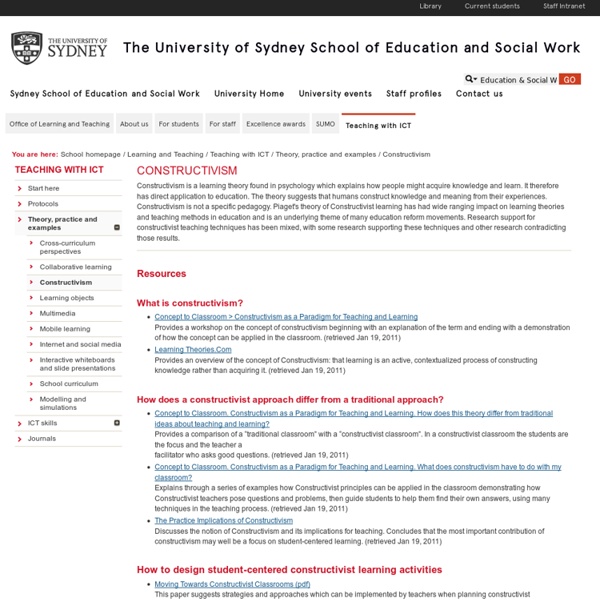The Fountain Magazine - Issue - CONSTRUCTIVISM in Piaget and Vygotsky
Issue 48 / October - December 2004 CONSTRUCTIVISM in Piaget and Vygotsky Ozgur Ozer Constructivism is a new approach in education that claims humans are better able to understand the information they have constructed by themselves. According to constructivist theories, learning is a social advancement that involves language, real world situations, and interaction and collaboration among learners. The learners are considered to be central in the learning process. In constructivist classrooms, unlike the conventional lecturer, the teacher is a facilitator and a guide, who plans, organizes, guides, and provides directions to the learner, who is accountable for his own learning. Jean Piaget and Lev Vygotsky are two eminent figures in the development of constructivist theories. Piaget explores four sequential stages of the psychological development of the young learner and believes teachers should be cognizant of these stages.
Constructivism: From philosophy to practice
Socrates(470-399 B.C.) Knowledge is only perception. Socrates Knowledge is not a transferable commodity and communication not a conveyance E. von Glasersfeld (1987) The world presents itself to us, effectively Which worlds? ...learning theories or models are rarely developed to a point where they can be more or less operationalized.Mendelsohn & Dillenbourg (1994) Constructivism does not claim to have made earth-shaking inventions in the area of education; it merely claims to provide a solid conceptual basis for some of the things that, until now, inspired teachers had to do without theoretical foundation.E. Socrates liked to work with students. Socrates is not generally associated with constructivist philosophy. How we perceive knowledge and the process of coming to know provides the basis for educational practice. The aim of this site is to highlight some of these attempts at integrating constructivist characteristics into the practice of teaching and learning. Socrates is now online.
constructivism notes from variety of sources
Elementary students learn keyboard typing ahead of new Common Core tests
The 7-year-olds in Natalie May’s class have to stretch their fingers across the keyboards to reach “ASDF” and “JKL;” as they listen to the animated characters on their computer screens talk about “home keys.” “After 15 minutes, some of them will say their fingers are hurting, so we take a break,” said May, a Phoenix educator who began teaching typing to second-graders this school year. Of the major shifts taking place in American classrooms as a result of the new national Common Core academic standards, one little-noticed but sweeping change is the fact that children as early as kindergarten are learning to use a keyboard. A skill that has been taught for generations in middle or high school — first on manual typewriters, then electric word processors and finally on computer keyboards — is now becoming a staple of elementary schools. Educators around the country are rushing to teach typing to children who have barely mastered printing by hand. The standards do not dictate curriculum.
Answers to Constructivism
The History of the Internet and the Colleges That Built It
Today, without access to Wikipedia and Google, many students would struggle to punch out that last research paper for a psychology class. The Internet has changed higher education and made it more accessible to many students — and without higher education institutions, the Internet may never have become the amazingly versatile tool it is today. Here’s a look at a few key moments in the history of the Internet. 1945: Sci-fi author Arthur C. Clarke envisions satellite network. Clarke first proposed an advanced communication network using geosynchronous satellite technology, which is all the more astounding because Clarke had anticipated this well over a decade before Sputnik 1 was even launched! 1961: Enter Howard Hughes. Hughes had originally formed the Hughes Aircraft Company in 1932, with the primary goal of developing aerospace technology for the United States government. 1963: Syncom 2 is launched. 1963: Accolades for Clarke. The Franklin Institute awarded Arthur C. 1983: Domains.
How is knowledge constructed? / Knowledge and theory / INSTEP - INSTEP
The construction of knowledge is a dynamic, active process in which learners constantly strive to make sense of new information. Over time, this sense-making activity is made up of conscious attention, organising and reorganising ideas, assimilating or accommodating to new ideas, and constant reshuffling and reorganising in efforts to connect ideas into coherent patterns. Stoll et al., 2003, pages 24–25 What a learner understands from a new message or experience depends critically on the knowledge they already have. Sense-making is not a simple decoding of the … message; in general, the process of comprehension is an active process of interpretation that draws on the individual’s rich knowledge base of understandings, beliefs, and attitudes. Spillane et al., 2002, page 391 Timperley et al. (2007) describe four learning processes through which people may engage with new knowledge, each of which is associated with a different outcome. page 18 Return to top
Constructivism as a Paradigm for Teaching and Learning
What is constructivism? How does this theory differ from traditional ideas about teaching and learning? What does constructivism have to do with my classroom? Expert interview What is the history of constructivism, and how has it changed over time? What are some critical perspectives? What are the benefits of constructivism? What are the benefits of constructivism? . Children learn more, and enjoy learning more when they are actively involved, rather than passive listeners. . Education works best when it concentrates on thinking and understanding, rather than on rote memorization. Constructivist learning is transferable. Constructivism gives students ownership of what they learn, since learning is based on students' questions and explorations, and often the students have a hand in designing the assessments as well. By grounding learning activities in an authentic, real-world context, constructivism stimulates and engages students. © 2004 Educational Broadcasting Corporation.



